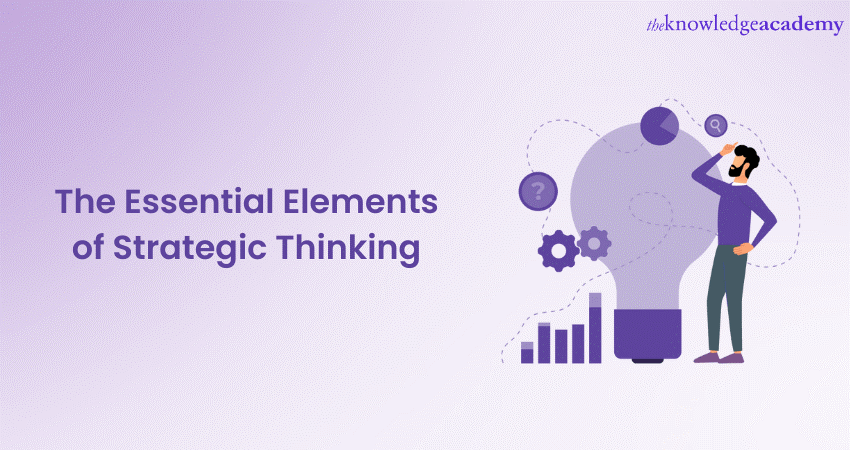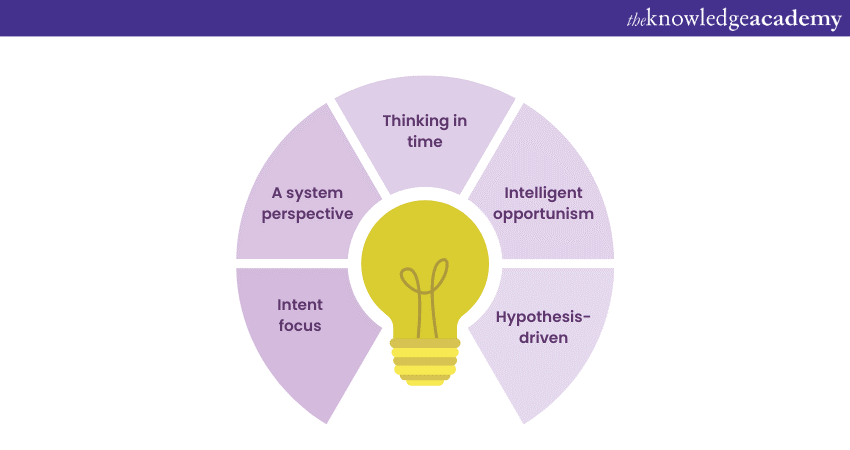We may not have the course you’re looking for. If you enquire or give us a call on +44 1344 203 999 and speak to our training experts, we may still be able to help with your training requirements.
Training Outcomes Within Your Budget!
We ensure quality, budget-alignment, and timely delivery by our expert instructors.

Strategic Thinking is a crucial skill that enables individuals and organisations to make informed decisions, navigate uncertainties, and achieve long-term goals. It represents a systematic and analytical approach to problem-solving and decision-making. In this blog, we will explore the five essential Strategic Thinking Elements and how they contribute to effective planning and execution.
Table of Contents
1) What is Strategic Thinking?
2) What are the 5 key elements of Strategic Thinking?
a) Intent focus
b) A system perspective
c) Thinking in time
d) Intelligent opportunism
e) Hypothesis-driven
3) Benefits of Strategic Thinking Elements
4) Conclusion
What is Strategic Thinking?
Strategic Thinking can be defined as a cognitive process that involves analysing complex situations, thinking critically, and making informed decisions to achieve long-term goals. It goes beyond day-to-day problem-solving and focuses on the bigger picture, considering the broader context and envisioning the desired future state.
Strategic Thinking involves analysing complex situations, making informed decisions, and envisioning long-term goals. It requires a proactive, systems-oriented, and analytical approach coupled with adaptability and collaboration.
At its core, Strategic Thinking involves taking a proactive approach, anticipating challenges, and positioning oneself for success. Analytical thinking and collaboration are crucial aspects of Strategic Thinking. Moreover, Strategic Thinking requires adaptability and the ability to respond to changes in the business landscape.
Strategic thinkers embrace innovation, remain open to new ideas, and adjust strategies as necessary. They proactively seek feedback, learn from failures, and iterate their approaches, enabling them to stay ahead in a rapidly evolving environment. Developing Strategic Thinking skills takes time and practice, but the rewards are substantial—a sharper strategic focus, improved decision-making, and a competitive advantage in the modern world.
Take charge of your personal and professional growth with our Strategic Planning and Thinking Course. Unlock your Strategic Thinking potential today!
What are the 5 key elements of Strategic Thinking?
Now that we have understood what Strategic Thinking is, we will explore the 5 elements of Strategic Thinking. In this section, we will examine the five elements of Strategic Thinking.

Intent focus
Intent focus in Strategic Thinking Elements is about having a clear and unwavering direction in Strategic Thinking. It involves setting specific and measurable goals that align with the overarching vision. Strategic thinkers clearly define their intent and communicate it effectively to their team or stakeholders.
By maintaining a clear focus on the desired outcomes, they can prioritise their efforts, make informed decisions, and allocate resources strategically. Intent focus provides a guiding compass that keeps everyone aligned and motivated, driving progress towards long-term success.
A system perspective
A system perspective in Strategic Thinking Elements involves understanding the interconnected nature of various components within a system. Strategic thinkers recognise that actions or changes in one part of the system can have ripple effects on other Strategic Thinking Elements. They consider the broader ecosystem, including internal and external factors, stakeholders, market dynamics, and industry trends.
By analysing the complex web of relationships and dependencies, strategic thinkers can identify leverage points, anticipate potential bottlenecks, and develop holistic strategies that address multiple aspects of the system. A system perspective allows for comprehensive decision-making and minimises unintended consequences.
Thinking in time
Thinking in time refers to the ability to integrate historical perspectives and future projections into Strategic Thinking. Strategic Thinkers delve into the past to understand patterns, trends, and lessons learned from previous successes and failures. They gain valuable insights that inform their decision-making process by studying historical data and analysing past strategies.
Additionally, thinking in time involves considering future scenarios and potential developments. Strategic Thinkers engage in foresight activities, scenario planning, and trend analysis to anticipate future challenges and opportunities. By thinking in time, they make informed decisions that draw from both the past and future, increasing the likelihood of achieving long-term success.
Intelligent opportunism
Intelligent opportunism involves being receptive to unexpected opportunities that arise during the strategic journey. Strategic Thinkers remain agile and adaptable, continuously scanning the environment for emerging trends, market shifts, and unforeseen circumstances. They embrace ambiguity and uncertainty, recognising that hidden opportunities often lie within challenging situations.
When an opportunity aligns with their strategic objectives, they seize it strategically, leveraging their resources and capabilities. Intelligent opportunism allows for flexibility in adjusting strategies, capitalising on unanticipated events, and staying ahead of the competition.
Hypothesis-driven
A hypothesis-driven approach is characterised by formulating assumptions or hypotheses and actively testing them through data analysis and experimentation. Strategic Thinkers develop hypotheses based on available information and prior knowledge. They gather relevant data, conduct research, and engage in rigorous analysis to validate or invalidate their assumptions.
This hypothesis-driven approach allows them to make evidence-based decisions and adapt their strategies based on new insights. By remaining open to learning, challenging assumptions, and adjusting their course of action, Strategic Thinkers can mitigate risks, uncover new opportunities, and optimise their strategic outcomes.

Benefits of Strategic Thinking Elements
Strategic Thinking offers numerous benefits for individuals and organisations. By cultivating and applying Strategic Thinking Elements, individuals can enhance their decision-making, problem-solving, and planning capabilities, leading to greater success and effectiveness in various aspects of their lives. Here are some key benefits of Strategic Thinking:
Clear direction
Strategic Thinking Elements provide individuals with a clear direction and purpose. By aligning goals and actions with a larger vision, individuals gain a sense of focus and clarity. They can identify what is truly important and make decisions that support long-term objectives. This clarity enables individuals to prioritise their efforts, allocate resources effectively, and avoid getting overwhelmed by day-to-day distractions.
Proactive approach
Strategic Thinking Elements empower individuals to adopt a proactive rather than reactive approach. Instead of merely responding to immediate challenges, they anticipate future trends, risks, and opportunities. By thinking ahead and considering different scenarios, they can prepare for potential obstacles, mitigate risks, and capitalise on emerging opportunities. This proactive mindset allows individuals to stay ahead of the curve and take advantage of changing circumstances.
Improved decision-making
Strategic Thinking Elements enhance decision-making by providing a structured framework for evaluating options and assessing potential outcomes. It involves gathering and analysing relevant data, considering multiple perspectives, and weighing the pros and cons of different courses of action. Strategic thinkers make informed decisions based on evidence and long-term considerations. This leads to more effective and successful outcomes, as decisions are grounded in careful analysis and strategic alignment.
Effective problem-solving
Strategic Thinking Elements equip individuals with a systematic approach to problem-solving. Rather than merely addressing symptoms, strategic thinkers identify underlying causes and develop comprehensive solutions. They consider the broader context, stakeholders' perspectives, and potential consequences. By applying critical thinking and creativity, strategic thinkers can tackle complex problems and generate innovative solutions that address the root causes.
Enhanced adaptability
Strategic Thinking Elements enable individuals to adapt and respond effectively to new challenges and opportunities. It encourages flexibility and open-mindedness, allowing individuals to adjust their strategies as needed. Strategic thinkers embrace change, leverage their strengths, and explore new approaches. This adaptability helps them thrive in dynamic environments, seize emerging trends, and navigate uncertainties with agility.
Competitive advantage
Strategic Thinking Elements provide individuals and organisations with a competitive edge. Strategic thinkers can position themselves ahead of competitors by analysing the market landscape, identifying gaps, and anticipating future trends. They can identify untapped opportunities, design innovative products or services, and separate themselves from the competition. Strategic Thinking enables individuals and organisations to anticipate market shifts, stay relevant, and maintain a competitive advantage.
Long-term success
Strategic Thinking Elements are essential for long-term success. Strategic thinkers can ensure sustainability and avoid short-term thinking by considering the broader implications of actions and decisions. They take a holistic view of success, considering financial, social, and environmental factors. Strategic thinkers focus on creating value and achieving sustainable growth, leading to long-term success and resilience.
Conclusion
All in all, Strategic Thinking is a multifaceted skill that combines visionary perspective, systems thinking, analytical mindset, adaptive agility, and collaborative engagement. By cultivating these five Strategic Thinking Elements, individuals and organisations can enhance their ability to navigate complex challenges, make informed decisions, and achieve long-term success. Developing Strategic Thinking skills takes time and practice, but the rewards are substantial—a sharper strategic focus, improved decision-making, and competitive advantage.
Transform your potential into success with our comprehensive Personal Development Training Courses. Join now and unlock your true capabilities!
Frequently Asked Questions
Upcoming Business Skills Resources Batches & Dates
Date
 Strategic Planning and Thinking Course
Strategic Planning and Thinking Course
Fri 31st Jan 2025
Fri 21st Feb 2025
Fri 21st Mar 2025
Fri 30th May 2025
Fri 18th Jul 2025
Fri 19th Sep 2025
Fri 21st Nov 2025







 Top Rated Course
Top Rated Course


 If you wish to make any changes to your course, please
If you wish to make any changes to your course, please


